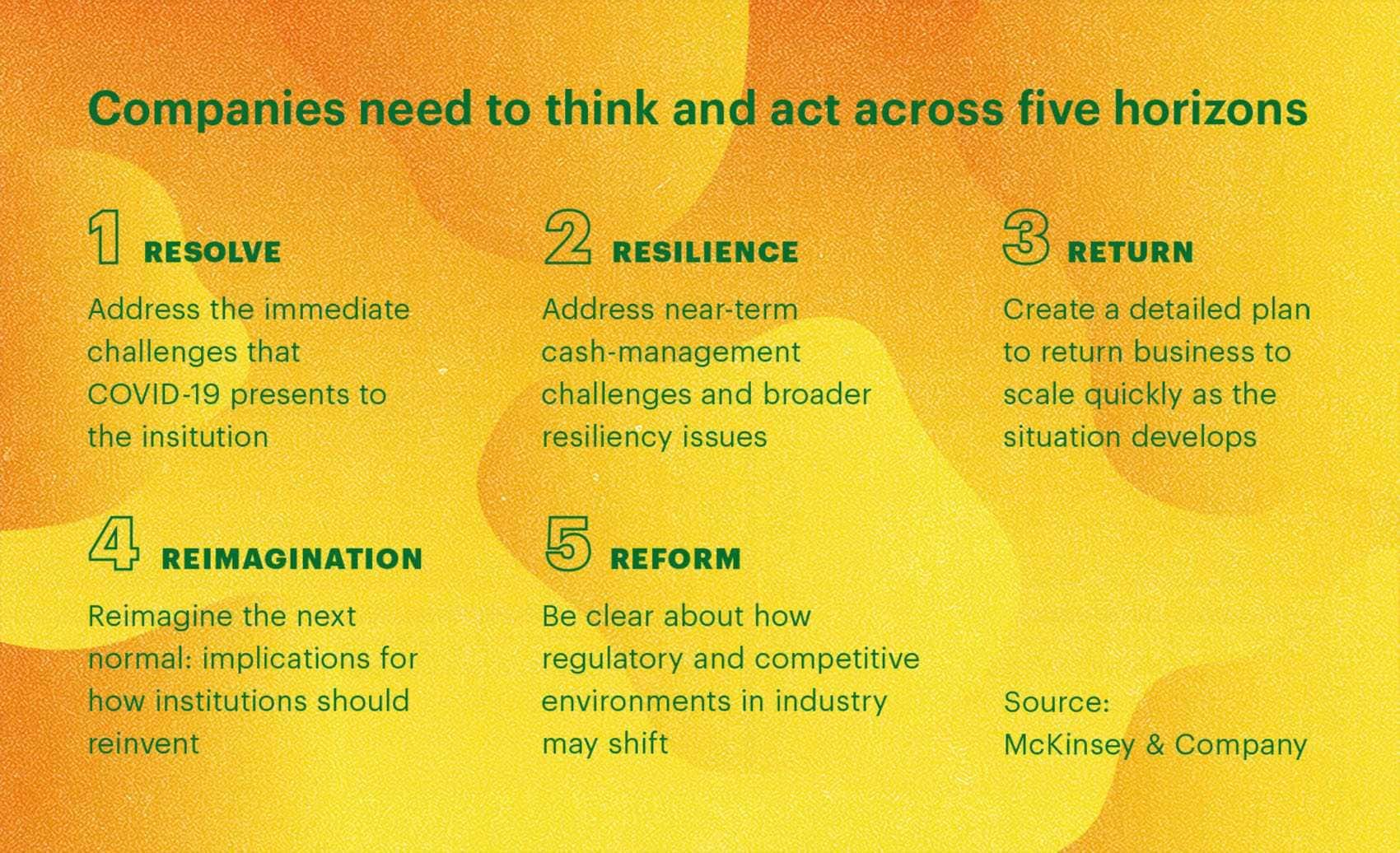
Strategies for building a resilient business
Main illustration: Kristin Raymaker
The past few weeks have shown us how important it is for all of us to deeply empathize with those around us.
With that comes the need for clear communication and open dialogue with customers and employees alike. These are all key components of a business resilience strategy, one that bolsters up a business that’s faced with challenges and sets it up for growth long-term.
In March, McKinsey & Co. published guidance for leaders who need to steer their business through the challenging times ahead. While the guidance is specific to the Covid-19 crisis, the general framework can be applied to other crises that emerge, including the important discussion on racial justice that’s currently taking place. Authors Kevin Sneader and Shubham Singhal suggested that companies plan their next actions across the “five horizons” of resolve, resilience, return, reimagination, and reform, as seen here:

The first priority for leaders during a crisis is to address immediate needs of their employees and customers. After tackling this “Resolve” stage, leaders should turn their attention to shoring up future operations and building general business resilience. In fact, Sneader and Singhal cautioned that this second stage and its outcomes will have long-term implications on most (if not all) businesses:
“In the face of these challenges, resilience is a vital necessity. Near-term issues of cash management for liquidity and solvency are clearly paramount. But soon afterward, businesses will need to act on broader resilience plans as the shock begins to upturn established industry structures, resetting competitive positions forever.”
How should businesses think about long-term financial success as they move past addressing immediate business continuity challenges? What will be necessary to ensure long-term growth in the post-pandemic world, especially as our customers’ needs continue shifting in ways we can’t yet predict?
We spoke to leaders at companies such as Lattice, Yotpo, and Frontify to get their take. We asked what kinds of resiliency plans they’re developing, both for the current moment and in the future. Here are a few of the strategies they shared and how you can apply them to your own business as you move forward.
Make decisions quickly
We asked Mark Weidick, the general manager of legal ops platform SimpleLegal, what he thought was most important about leadership during a crisis. Weidick cited Colin Powell’s 40/70 approach to leadership, which advises business leaders not to make decisions based on “gut feeling” – or less than 40% confidence – but also not to reach a state of “paralysis by analysis” – over 70% confidence.
This “paralysis” is much like what many businesses are experiencing in the first stage in Sneader and Singhal’s action plan, called “Resolve.” As they wrote:
“A toxic combination of inaction and paralysis remains, stymying choices that must be made: lockdown or not; isolation or quarantine; shut down the factory now or wait for an order from above. That is why we have called this first stage Resolve: the need to determine the scale, pace, and depth of action required at the state and business levels.”
Weidick shared with us that the best leaders are those who make decisions quickly, with just enough information to take action. Rather than waiting for everyone to agree or for “perfect” communication to be developed, they move ahead, so necessary change can take place.
 |
“Great leaders are visible, informed, accessible, decisive and overly communicative in crisis situations. I’ve seen the ‘decisive’ part of leadership cause the biggest problems, typically when a leader waits for better or perfect information.” |
SimpleLegal’s own example of a fast decision came in the form of moving to a remote work situation earlier than officially advised:
“Our business continuity team concluded we should move to a work-from-home approach a couple of days prior to the Santa Clara County mandate to do so. We had a few examples of other organizations who acted sooner and we could see the makings of a trend line from elementary through high schools, so we made the decision to act in the best interest of the safety and well-being of our employees and the community by moving to work-from-home.”
Tomer Tagrin, CEO of the e-commerce marketing platform Yotpo, agreed with Weidick’s sentiments. He also shared how important it is that leaders communicate clearly about these decisions, whether this comes in the form of a weekly Slack message to the team or occasional emails and in-app notifications to customers:
 |
“Consistency in how and what leaders communicate is critical – this is a time for clear communication, listening to concerns, and above all, empathy.” |
Leaders who want to build resiliency must make fast decisions with just enough data to back them up. After these decisions have been made, it’s up to them to communicate quickly and clearly to everyone who depends on the business – employees, customers, partners, and stakeholders – so that no one is left in the dark.
If you’re not sure what to say or how to say it, consult with a few trusted members of your team. It’s better to be present and show empathy than not to show up at all.
Consider the needs of your employees
Consistently attending to your employees’ needs and keeping a pulse on what they’re experiencing both at work and beyond is essential. Never has this been more critical than in the current discussions around racial equality.
Strategy consulting firm Paradigm recently published a guide for managers on how to support Black employees, especially during this time. A couple of key takeaways include:
- Managers should check in with employees individually to see what each team member needs, with an understanding that everyone is experiencing things differently.
- Managers should ask what they can take off each team member’s plate. Ask if they need to take time off.
Considering the needs of employees also comes in the form of understanding their needs during other types of crises, like the current global pandemic.
A recent tweet from Neil Webb, Director of the British Council Theater and Dance, aptly described the difference between remote work in general and remote work in the era of COVID-19:
“You are not working from home; you are at your home during a crisis trying to work.”
I’ve heard this twice today. I think it’s an important distinction worth emphasising.
— Neil Webb (@neilmwebb) March 31, 2020
Your employees aren’t just working from home; they’re working from home during a global pandemic. Even if your organization was partially or fully remote prior to March of this year, each member of your organization has been affected in some way. They may be struggling to work with their family around 24/7, or alternatively could be feeling isolated.
McKinsey has called for businesses to “support and protect employees in this brave new world,” asking leaders to think closely about the needs of their employees above all else. This means adjusting both communication and “working norms”:
“Companies need to increase communication, balancing the needs of the business with expectation setting and morale building, so employees know that their well-being is top of mind. They also need to change working norms, making remote work practical and simple whenever possible.”
Several of the leaders we spoke to have taken this advice to heart. Gary Lipkowitz, the CEO of video animation software Vyond, told us that they’ve upped the cadence of their internal communication. For example, when Vyond decided against applying for a loan, employees were notified:
 |
“We had a lot of long internal discussions about the Payroll Protection Program, for instance. Ultimately we decided it was not ethical to apply for the loan since things were going well for us. But we needed to clearly communicate this decision and its rationale internally so that our team didn’t perceive us as being cavalier about the risks ahead, or their job security over the long haul.” |
As far as flexibility is concerned, even remote-friendly companies are finding new ways to connect and support employees working from home. Jaclyn Kalb, general manager of Frontify, told us that they’ve picked up a new habit where teams hold short “huddles” first thing in the morning:
 |
“We’ve always offered employees flexibility and autonomy thanks to our unique company culture including the choice of being in an office, spending free time together and championing one another both professionally and personally. We’ve adapted, having a 15 min morning ‘Daily Huddle’ allowing our team to connect. It’s a light touch, but also a powerful forum for us to connect and support one another.” |
Kalb also stressed how important this employee empowerment is to improving the long-term health of a B2B organizations like hers.
As Kalb says, putting your people first, especially in stressful times, creates a ripple effect for B2B organizations. Happier employees do better work and support customers better. And when your customers have the support they need to succeed with your product, their own businesses are more likely to succeed.
Ask customers what they need now – and next
What do your customers need during a time of business instability? Is it the same as always, or do their needs dramatically shift?
This is the thinking behind the “Reimagination” stage Sneader and Singhal detailed in their report, a “discontinuous shift in the preferences and expectations of individuals.” McKinsey shows this as a separate stage, one to be pursued after resiliency plans are set in stone. However, many of the leaders we spoke to said that they’ve already begun reimagining their offerings based on current customer needs.
Jack Altman, CEO of people management platform Lattice, says they’re seeing a shift in feature usage for their platform. Managers must keep an eye on the morale of a workforce largely unaccustomed to full-time remote work, so Lattice’s weekly updates and sentiment tracking are being used more than ever.
Altman says the Lattice platform itself is being maintained for “uptime and reliability,” so their strongest response to customer needs has come in the form of content creation:
 |
“We’re shifting our focus to provide assets, resources, and pandemic-specific support to our customers. [We want to] guide, inform, and empower our audience to successfully navigate these uncertain times.” |
David Kofoed Wind, CEO of learning experience platform Eduflow, says their platform’s weekly active users are up 600%. As a result, the business has re-prioritized their marketing efforts for the next few weeks. Right now, Eduflow users need content and documentation, so they’ve scaled up support for current customers, and they’ve scaled back sales efforts:
 |
“Most of our effort is being put towards product improvements that will lead to customer retention. This includes spending resources on improving onboarding flows, increasing stability and writing better documentation. […] Now is not the time for monetizing and selling hard. The hope is that this focus on new users and proving value will deliver us additional revenue in the future.” |
Amanda Morgan, senior marketing manager at Vyond shared that Vyond is working to connect their community of media creators, namely by holding virtual events. They’re doubling down on these efforts in the immediate future so that they can create a feeling of community for their users who are now otherwise separated and may potentially be feeling isolated or in need of support.
Finally, Jaclyn Kalb of Frontify suggests finding new ways to connect with, listen to, and receive feedback from customers. By being open to new methods of communication, you can build relationships that may bear fruit in the future:
 |
“I’m learning and experimenting with ways to engage with customers via online methods that aren’t purely a demo or business call. I’ve found you can be a resource and source of support to internal and external clients via alternate methods of communication. I firmly believe in-person will always reign supreme but technology is propelling us forward to build bridges when a 1:1 isn’t possible.” |
In the B2B world, resiliency comes from listening closely to what your customers need – whether this need is temporary or will become their new reality – and quickly offering support. If you’re not sure what your customers want right now, take the time to ask: send out a survey or email – something we did as a Content Team – or talk to your support team. Then, work together with your teams to determine how you can respond, whether that’s by making small improvements to your product or creating new forms of content.
Give your partners a helping hand
Business resiliency depends on several factors beyond those of your customers and employees, one of them being the other businesses you choose to partner with. Right now, many organizations are investing more deeply in these partnerships. The resulting investment gives you both a steady stream of referral traffic or commission, which in turn contributes to your collective financial success during trying times.
Here at Intercom, we’ve launched two new programs for our partners: one for App Partners and another for Service Partners. Partnerships have always been an important part of the way our company works, and we think that both of these programs will help businesses build stronger, longer-lasting relationships with their customers, bolstering business resilience along the way.
Partnerships and integrations maximize the value that customers get from using your products. The more they use your product, the stickier they become as customers, leading to better retention for all.
We’ve seen that come alive for partners like Clearbit, who saw their partnership with us yield over $100,000 in impacted revenue in the last year alone. And for Typeform, who noted that “Customers who use our Intercom app retain 60% better and bring a 9% higher MRR than our average customer.”
Ecommerce marketing platform Yotpo has integrations that allow businesses to improve how they sell online, too. CEO Tomer Tagrin says they’re reaching out to the partners behind these integrations to make sure they are healthy and supported in this time of need:
 |
“Our Partner team is responding with a specialized action plan to meet the needs of our partners and their clients to provide them with ongoing success opportunities and ensure they are supported. We strongly believe that mutual commitment and solidarity are key to weathering this storm together.” |
Tagrin also talked to us about how Yotpo is strengthening their partner community with virtual events. The company recently held a virtual town hall to discuss trends in ecommerce. During this town hall, partners also received data from a recent survey, plus updates on how Yotpo was addressing the pandemic.
By making an effort to reach out to your partners, you’re reinforcing just how important your partnerships are to your business. And by working together to improve your collective revenue, you’re contributing to the financial resiliency of both of your organizations.
Look for ways to improve business performance
As Kevin Sneader and Shubham Singhal wrote for McKinsey, there are opportunities here to lean into customer feedback, employee nurture, and business partnerships. The businesses that do this are the ones that will find themselves better able to weather not just this storm, but future storms, too.
As you prepare to plan out – or execute – your business resilience plan, keep the learnings we’ve shared from these B2B leaders in mind. There’s no telling how long the current crisis will last, but we’re confident that by sharing our knowledge and experiences, we can all make it through to the other side – together.






